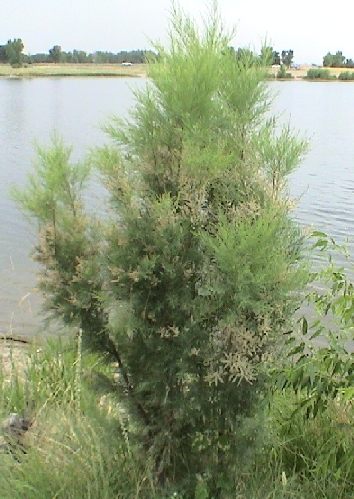Saltcedar (Tamarix ramosissima)
Identification
Saltcedar is a deciduous or evergreen shrub or small tree, typically growing 5 to 30 feet tall. The bark is reddish-brown and the leaves are small and scale-like and overlap each other on the stem. Thousands of small pink to white flowers appear from March to September. Saltcedar reproduces by root spread and by seed and can produce up to 500,000 seeds per plant per year. The small seeds have a tuft of hair attached to the end allowing them to float long distances on the wind and water.
Saltcedar was introduced into North America in the early 1800’s from southern Europe or the eastern Mediterranean region. It was originally used for ornamental plantings (landscaping) as well as for windbreaks and erosion control. By the mid-1800’s, Saltcedar had escaped and infested many of the rivers and drainages in the Southwestern part of the Country. As a result, native plants have been displaced. Currently, Saltcedar infestations are common in most river systems from California to Texas, even in Florida. In Colorado, Saltcedar is widespread along the South Platte River in Adams County and along the Colorado River near Glenwood Canyon. The Arkansas River in the southern part of the State is impacted by dense Saltcedar infestations as well.
Why is Saltcedar such a problem? First of all, Saltcedar loves water. It loves water so much that a single plant will consume about 200 gallons per day while it is actively growing. With that kind of water consumption, the total water flow along rivers and drainages can be reduced or even eliminated. Combine that with the drought Colorado is in and our rivers are in serious jeopardy. Another problem is how saltcedar affects the soils it grows in. Once it invades an area, Saltcedar exudes salt from its leaves, which in turn increases the salinity of the surrounding soils. The excreted salts will eventually form a saline crust on the soil. As a result, native plant establishment is prevented. Without native plants, such as cottonwoods, willows, grasses, and forbs, the population and diversity of wildlife is drastically reduced in infested areas.
Management of saltcedar requires a long-term commitment and a lot of persistence utilizing a variety of methods, including mechanical, chemical, and cultural. Once an infested area is successfully managed, re-invasion must be prevented to achieve long-term control. This can be done by revegetating the area with beneficial plants that are salt-tolerant. Still, the best method of all is prevention.




